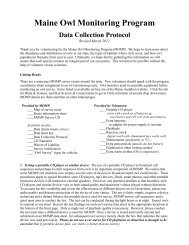Focus Species Forestry - Maine Audubon
Focus Species Forestry - Maine Audubon
Focus Species Forestry - Maine Audubon
Create successful ePaper yourself
Turn your PDF publications into a flip-book with our unique Google optimized e-Paper software.
For riparian and wetland areas and vernal pools, refer to recommendations in Section 5.<br />
Follow recommendations provide by the <strong>Maine</strong> Natural Areas Program or Department of<br />
Inland Fisheries and Wildlife for other special-value areas such as deer wintering areas<br />
and rare plant habitat. For more information, see Biodiversity in the Forests of <strong>Maine</strong><br />
(Flatebo et al. 1999) for guidelines on identification and management.<br />
Step 4. Review habitat management guides.<br />
Section 5 includes descriptions and habitat management guides for each of the 6 forest<br />
ecosystem types and special-value habitats covered by this manual.<br />
Recommendations:<br />
Review the management recommendations for the forest ecosystems and special-value<br />
habitats found on the property.<br />
Step 5. Identify focus species and review species management<br />
recommendations.<br />
Section 6 includes biological information and management recommendations for each of the<br />
focus species featured in this manual.<br />
Use Figure 1 (Section 6) to identify the region of the state where the property is located.<br />
For a “quick start” approach, use the short list of “primary” focus species in Appendix 9;<br />
use other focus species as time and landowner interest allow.<br />
The <strong>Focus</strong> <strong>Species</strong> Management Worksheet (Appendix 5) can be used to summarize the<br />
data.<br />
List forest ecosystem types and special-value habitats from Table 1 that are found on the<br />
property.<br />
For each ecosystem type and special-value habitat, list the focus species for the region on<br />
the worksheet. For properties near region boundaries, it may be appropriate to use the<br />
focus species for both regions. Use the habitat types on the property and in the<br />
surrounding landscape to help guide this decision.<br />
Review the management guidelines for each focus species identified for the property.<br />
For a quick reference, refer to the <strong>Focus</strong> <strong>Species</strong> Summary Table (page 62).<br />
Step 6. Identify appropriate mix of forest development stages and<br />
management activities.<br />
<strong>Focus</strong> species forestry involves maintaining suitable habitat for both early successional species<br />
and those that require mature and late-successional forests. The extent that this can be<br />
accomplished on a given ownership depends on ownership size and surrounding landscape<br />
conditions.<br />
Recommendations:<br />
Review the background information and management recommendations in Section 8, the<br />
guide to property-wide and landscape-scale forestry.<br />
<strong>Focus</strong> <strong>Species</strong> <strong>Forestry</strong> 9



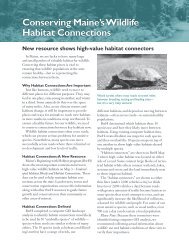
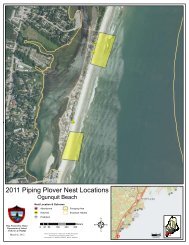
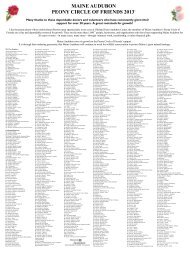
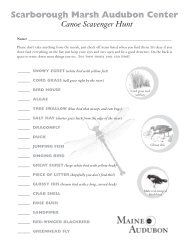


![2012 Loon Count Results [pdf] - Maine Audubon](https://img.yumpu.com/26228732/1/190x245/2012-loon-count-results-pdf-maine-audubon.jpg?quality=85)
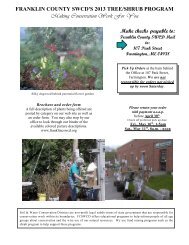
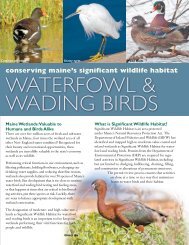
![Lake Fish of Maine (DIFW list) [pdf] - Maine Audubon](https://img.yumpu.com/23282964/1/190x245/lake-fish-of-maine-difw-list-pdf-maine-audubon.jpg?quality=85)
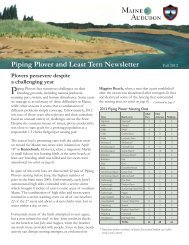

![The Maine Audubon Peony Circle of Friends 2012 [pdf]](https://img.yumpu.com/22707677/1/190x253/the-maine-audubon-peony-circle-of-friends-2012-pdf.jpg?quality=85)
